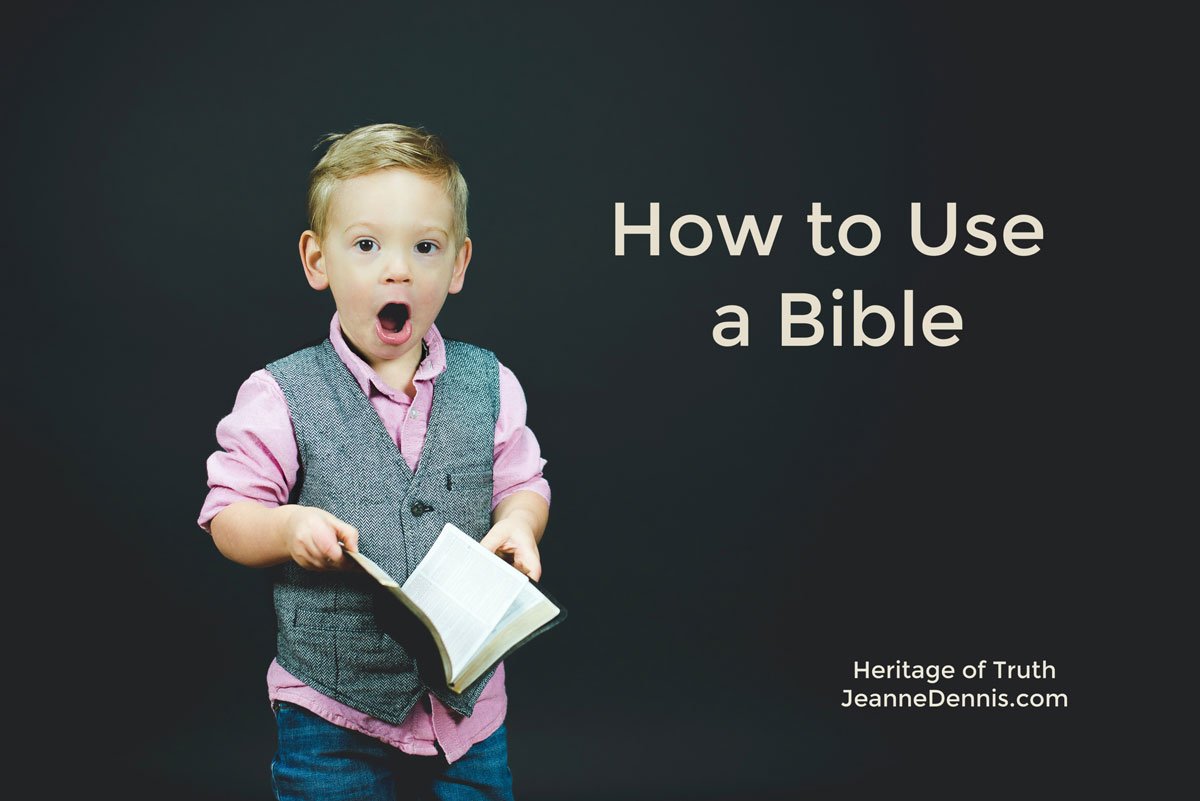How to Use a Bible
By Jeanne Dennis, Colson Fellow and Centurion
Do you know how to use a Bible? When I first came to know Jesus in my early thirties, I had no idea how to use a Bible or how to find Bible references.
Don’t feel awkward if you don’t know how. We all had to learn.
If you or your children don’t know how to use the Bible, this guide should help you learn. It explains how the Bible is arranged and how to find references.
Parts of the Bible
First of all, the Bible has two parts, the OLD TESTAMENT and the NEW TESTAMENT. The Old Testament contains the books written before Jesus Christ, Yeshua the Messiah, lived. The New Testament contains the books written from the time of Jesus until after his death and Resurrection and late into the First Century.
Abbreviations
Often the names of Bible books are abbreviated, or shortened, to save space. You can find some common abbreviations for Bible books in parentheses ( ) after the names of the books, below.
Old Testament Books
The Old Testament contains 39 books. Old Testament books appear in the order below, from top to bottom of each column, moving from left to right.
Genesis (Gen.)
Exodus (Ex.)
Leviticus (Lev.)
Numbers (Num.)
Deuteronomy (Deut.)
Joshua (Josh.)
Judges (Judg.)
Ruth
1 Samuel (1 Sam.)
2 Samuel (2 Sam.)
1 Kings
2 Kings
1 Chronicles (1 Chron.)
2 Chronicles (2 Chron.)
Ezra (Ez)
Nehemiah (Neh.)
Esther
Job
Psalms (Ps.)
Proverbs (Prov.)
Ecclesiastes (Eccl.)
Song of Solomon (Song of Songs) (Song of Sol.)
Isaiah (Isa.)
Jeremiah (Jer.)
Lamentations (Lam.)
Ezekiel (Ezek.)
Daniel (Dan.)
Hosea (Hos.)
Joel
Amos
Obadiah (Obad.)
Jonah (Jon.)
Micah (Mic.)
Nahum (Nah.)
Habakkuk (Hab.)
Zephaniah (Zeph.)
Haggai (Hag.)
Zechariah (Zech.)
Malachi (Mal.)
New Testament Books
The New Testament contains 27 books. New Testament books appear in the order below, from top to bottom of each column, moving from left to right.
Matthew (Matt.)
Mark (Mk.)
Luke (Lk.)
John (Jn.)
Acts
Romans (Rom.)
1 Corinthians (1 Cor.)
2 Corinthians (2 Cor.)
Galatians (Gal.)
Ephesians (Eph.)
Philippians (Phil.)
Colossians (Col.)
1 Thessalonians (1 Thess.)
2 Thessalonians (2 Thess.)
1 Timothy (1 Tim.)
2 Timothy (2 Tim.)
Titus
Philemon (Philem.)
Hebrews (Heb.)
James
1 Peter (1 Pet.)
2 Peter (2 Pet.)
1 John
2 John
3 John
Jude
Revelation (Rev.) or Apocalypse (Apoc.)
Chapters and Verses in the Bible
Chapters
Each book of the Bible has been divided into chapters to make its parts easy to find. Chapter numbers are the large numbers you will find on the pages of the Bible.
Verses
Each chapter in the Bible has been divided into verses. The small numbers you find to the left of lines or sentences in the Bible are the verse numbers. Smaller numbers and letters you might see to the right of words refer to notes in the margins or at the bottom of the page. These notes or cross-references are listed by the number of the verse.
How to Look up a Bible (or Scripture) Verse
Bible verses are written in a kind of shorthand, like this: 1 John 1:3.
The first part tells you the name of the book. In this case, the book is First John. The number after the book’s name is the chapter number, in this case, chapter 1. The number or numbers after the colon sign (:) tell you the verse number or numbers. In this case, verse three.
If you see something like this: 1 John 1:3,5 you would go to the book of First John, chapter one, and read verses three and five.
A dash between the verse numbers means that you would read from the beginning of those numbers to the end of those numbers. So if you see 1 John 1:3–5, you should go to the book called First John, find chapter 1, and read verses 3, 4, and 5.
You may also see numbers with a longer dash between them, like this:
1 John 1:3—2:5. This means that you should read the book of First John beginning at chapter 1, verse three, and ending at chapter 2, verse 5.
Where to Begin Reading
Most people who read the Bible for the first time do not start from the beginning and read straight to the end. It’s easier to read certain books first to get a feel for God’s message to you.
If you have never read the Bible before, the Book of John, Mark, or Luke would be a great place to start. In the Old Testament, you might enjoy starting with Genesis. Exodus, Psalms, Proverbs, Esther, Ruth, and Daniel.
Types of Writing in the Bible
The Bible contains various genres or styles of writing. A book could contain historical narrative, poetry, prophecy (offering messages from God and often foretelling the future), instruction, proclamation, etc.
In the gospels, for example, we read the biography of Jesus. But we also find instruction from His teachings; factual accounts of His miracles; proclamations of His identity as God, Messiah, and Lord; prophecies of the future, and stories (parables) told as lessons for the people.
Whatever part of the Bible we read, we need to understand that it is God’s true and infallible Word to us. It has been passed down faithfully through the centuries. (More on that later.)
Make it a habit to read the Bible every day. Your whole life will be better for it!
This resource has been provided to you by Jeanne Dennis – Heritage of Truth.

